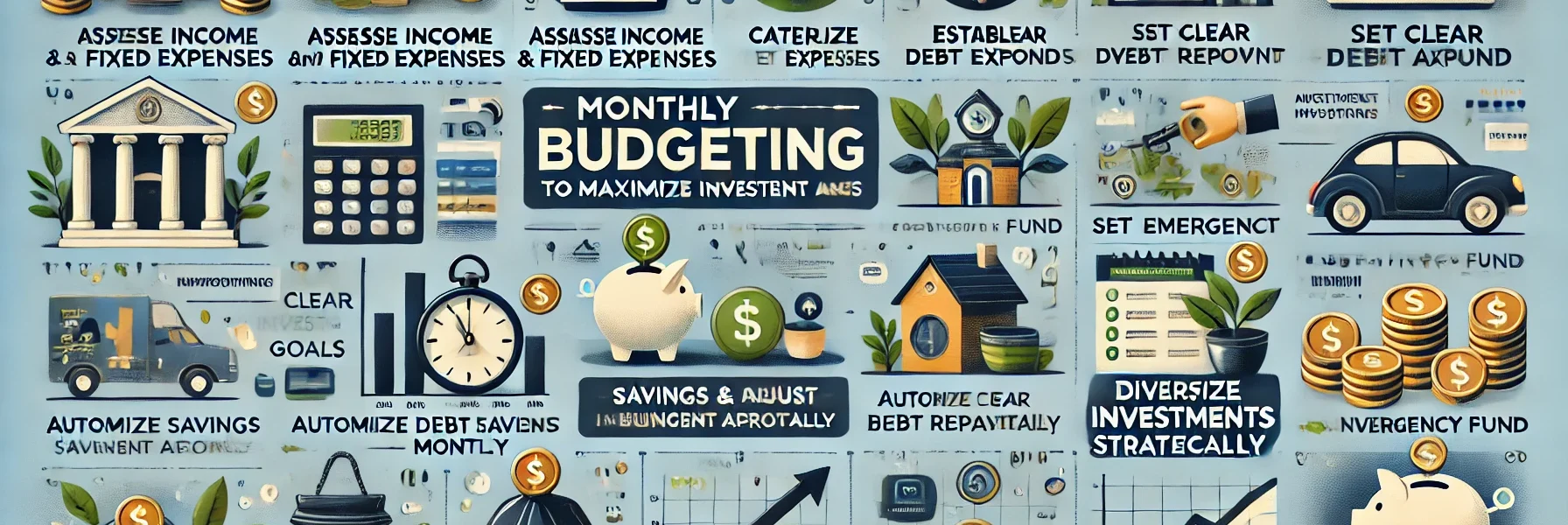In today’s fast-paced world, managing personal finances effectively is crucial to achieving long-term financial goals. One of the most effective ways to enhance your wealth is by creating a structured monthly budgeting plan that not only manages your expenses but also maximizes your investment returns. In this comprehensive guide, we will walk you through a monthly budgeting checklist that will help you stay organized, improve your financial health, and maximize your investment potential.
Why is Monthly Budgeting Important for Investment Success?
Budgeting is the foundation of financial stability. Without a clear understanding of where your money goes each month, it becomes challenging to allocate funds toward investments. A well-structured monthly budget enables you to:
- Track income and expenses accurately
- Identify areas for cost-cutting
- Set aside dedicated funds for investments
- Monitor financial progress over time
By following a monthly budgeting checklist, you can optimize your spending habits and increase the capital available for high-return investments.
1. Assess Your Income and Fixed Expenses
The first step in creating a successful monthly budget is understanding your income sources and fixed expenses. This includes:
- Income: Salary, freelance payments, rental income, dividends, etc.
- Fixed Expenses: Rent/mortgage, utilities, insurance premiums, loan payments
Tip: Documenting all sources of income and fixed obligations allows you to calculate your disposable income accurately.
2. Categorize Variable Expenses
Variable expenses fluctuate monthly and can impact your ability to invest consistently. Common categories include:
- Groceries
- Transportation
- Entertainment
- Healthcare
- Miscellaneous expenses
Tip: Review past bank statements to estimate an average for each category and identify opportunities to reduce discretionary spending.
3. Prioritize Debt Repayment
High-interest debt can erode your investment returns. Prioritize paying off credit cards and other high-interest loans to free up cash for investing.
- Snowball Method: Pay off the smallest debt first for psychological motivation.
- Avalanche Method: Pay off the highest-interest debt first to save on interest payments.
Tip: Allocate a portion of your budget specifically for debt repayment until you achieve a manageable debt-to-income ratio.
4. Establish an Emergency Fund
Before focusing on investment returns, it is critical to build an emergency fund. Aim to save 3-6 months’ worth of living expenses in a high-yield savings account.
Tip: An emergency fund acts as a safety net and prevents the need to liquidate investments during unforeseen circumstances.
5. Set Clear Investment Goals
Define specific and measurable investment goals to guide your budgeting strategy. Examples include:
- Saving for retirement
- Funding a child’s education
- Purchasing real estate
Tip: Align your investment goals with a suitable risk tolerance and time horizon for optimal returns.
6. Automate Savings and Investments
Automation simplifies budgeting and ensures consistency in contributing to investments. Consider:
- Setting up automatic transfers to savings and investment accounts
- Enrolling in employer-sponsored retirement plans (e.g., 401(k))
- Utilizing robo-advisors for automated portfolio management
Tip: Automating your savings minimizes the temptation to spend and helps you stay on track with long-term financial goals.
7. Monitor and Adjust Your Budget Monthly
Financial circumstances change, so it is essential to review your budget regularly. Assess:
- Variance between actual spending and planned budget
- Changes in income or expenses
- Progress toward investment goals
Tip: Use budgeting apps or spreadsheets to track monthly financial activity and identify trends requiring adjustment.
8. Maximize Tax-Advantaged Accounts
Utilizing tax-advantaged accounts can significantly boost investment returns. Options include:
- Individual Retirement Accounts (IRAs)
- Health Savings Accounts (HSAs)
- 529 Education Savings Plans
Tip: Maximize contributions to these accounts to benefit from tax deferral or tax-free growth, which enhances your overall returns.
9. Diversify Investments Strategically
A well-diversified investment portfolio reduces risk and enhances returns. Diversification strategies include:
- Investing across asset classes (stocks, bonds, real estate)
- Geographic diversification (domestic and international markets)
- Industry diversification (technology, healthcare, energy)
Tip: Regularly rebalance your portfolio to maintain your target asset allocation and risk profile.
10. Seek Professional Advice When Needed
Financial planning can be complex. Consult with a certified financial planner (CFP) to:
- Optimize your budget and investment strategy
- Ensure compliance with legal and tax regulations
- Receive personalized recommendations
Tip: Professional advice can provide insights and strategies to maximize your investment returns while minimizing legal risks.
Final Thoughts
A disciplined monthly budgeting checklist is key to achieving financial security and maximizing investment returns. By assessing your income, managing expenses, and setting clear goals, you create a solid foundation for wealth accumulation. Remember to review and adjust your budget regularly to stay on course and take advantage of new investment opportunities.
Adopting these budgeting best practices will not only help you build a robust financial future but also ensure you make the most of your investment potential while staying legally compliant. Start today, and take control of your financial destiny!




